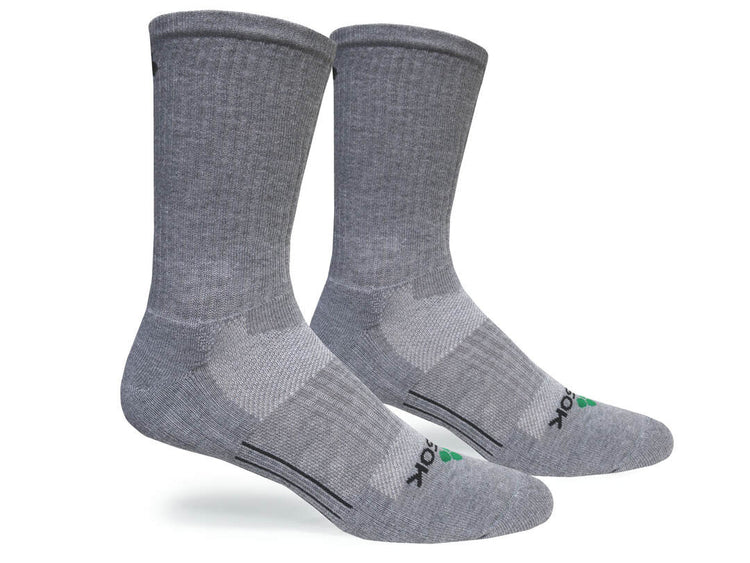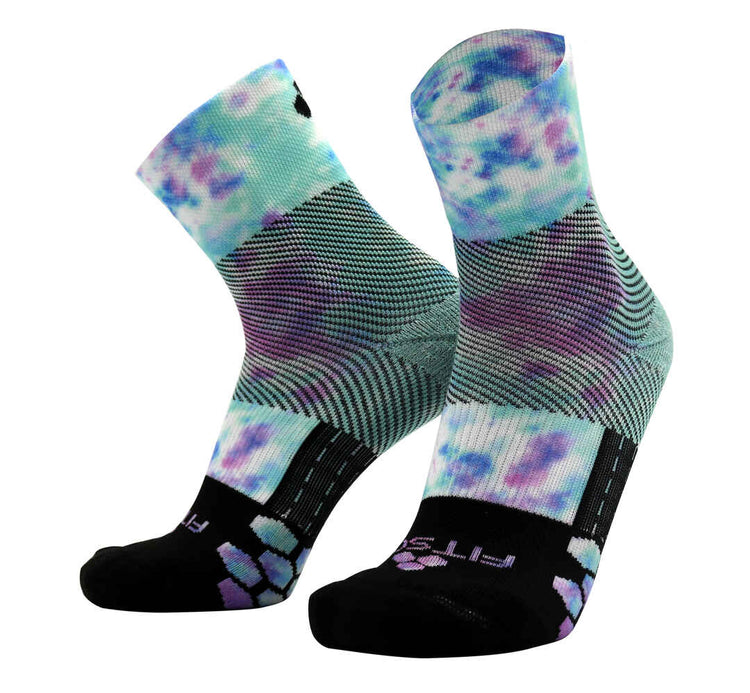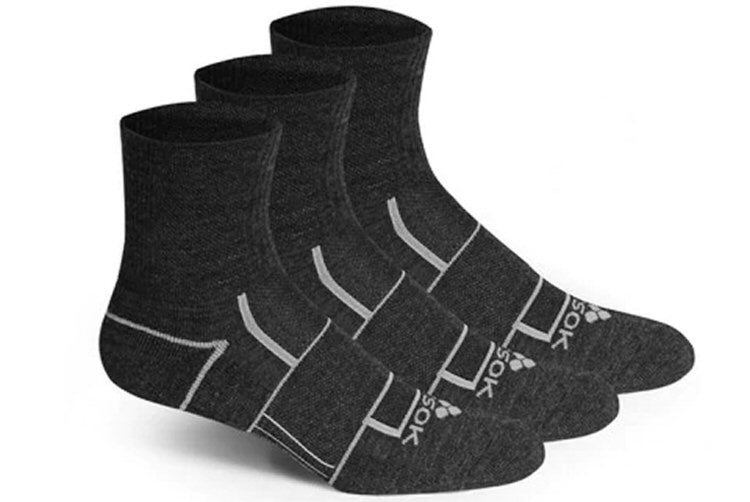What is a tempo run? Tempo runs are a way of helping you improve your running efficiency while improving your stamina and running form, and are described as ""comfortably hard"" or ""hard but controlled."" Tempo runs require a sustained, heightened effort over a specific period. It won't be easy, and it is not supposed to be. These types of runs are supposed to be harder than your usual jog or run.
When doing a tempo run, you will run a bit faster than your usual, comfortable running or jogging pace but not as quickly as you would run in an actual competitive race. These runs are typically for a shorter duration than your typical morning run. Typically, you'll be continuously running at an increased speed for about twenty to thirty minutes at a time. This is a type of threshold training meant to push your limits and eventually allow you to extend beyond them. The tempo pace is different for everyone and is customized specifically for you.
Finding your tempo pace is easy; you can use one of the many tempo pace calculators online, seek guidance from a trainer, or you can do it yourself with just a little bit of thinking. Start from your 5K speed. How long does it normally take you to typically run a 5K competitively? Now, slow that time down by about 25 or 30 seconds per mile. So if it takes you 30 minutes to run a 5k, your ideal tempo pace would be the speed you'd need to run to complete a 5K in around 31 and a half minutes. The pace is meant to be just a bit faster than is comfortable, but it should never feel like you're in a race.
There are two ways to think of tempo runs. The first is a steady run at this slightly increased pace for about 30 minutes. You can also take a slightly different approach and use shorter increased pace runs with shorter recoveries between them. A good example of this would be running 4 miles, but broken into four 1-mile bursts at tempo pace, with two minutes of jogging recovery at a more comfortable pace between each mile.
Since tempo runs are high-intensity, when adding them to your training schedule or routine, it is recommended you only do them once or twice a week, no more than 15% of your training time every week. They are hard on your body since it is threshold training. Meaning you are pushing your body's tolerance to its limit and creating a bigger threshold for faster-paced running in a shorter amount of time. Since you would be adding these to your training schedule, you are adding another high-impact form of workout. So on top of your speed training and usual long-distance running, you are pushing yourself pretty hard, making rest days rest days even more important.
When adding these to your routine, you will want to ensure you are stretching and taking proper care of yourself. Doing a good warm-up before starting your tempo run is crucial. Stretching is an integral part of warming up, you will want to loosen your muscles up before doing an intense run, as this helps prevents strains or injuries. Stretching after your run is also a good idea; it helps ease soreness and is good for helping your muscles and joints relax after being pushed harder than usual.
Making sure you have the proper gear for intense running will greatly benefit you, making sure you are as comfortable as possible during intense training. So investing in good running attire like shirts, shorts, pants, or leggings is a great way to add to your comfort levels since you will be doing something that is, by design, far from comfortable. Good running socks are also a great investment to make. Here at FitSok, we have a broad selection of running socks for anyone looking to get a great quality running sock made by people who know what you need. Running shoes can also significantly impact your comfort levels, so make sure you find a shoe that works great for you, as everyone has different needs and preferences. Try different brands and types of running shoes; you will want to ensure your feet are as comfortable as possible. Do some research and see if any particular shoe stands out to you; luckily, there are no shortages of running shoes for you to try!
Let's get into the benefits of tempo runs. There are many benefits to adding these to your training routine. They are a great form of cardio, you are hitting fast and hard, and it is going to help you burn off calories. Cardio is an important part of training and working out in general so doing these once or twice a week is perfect for adding a good dose of cardio into your schedule.
Another benefit of tempo running is that it improves your lactate clearance. Lactic acid is the by-product of exertion that creates the feeling of fatigue. You are intentionally spiking your lactic acid production by doing tempo runs, and your body is clearing it afterward. By doing this more frequently, your body gets better and better at clearing lactic acid from your system. This means it takes longer before your muscles feel fatigued, thus allowing you to run faster and longer over time. Cardiovascular fitness is also improved when doing tempo runs. Tempo runs get the blood flowing and the heart beating. Tempo runs can greatly improve your mental strength. Mental strength is just as important as physical strength, especially for long-term and long-distance running. Tempo runs are not easy, and being able to push yourself through them can help you train your mind to keep going when you reach mile 25 of your next marathon
Lastly, tempo runs improve your run time. A primary goal of tempo running is to improve your run time and the distance you can run at speed. These runs push you towards your goals if you embrace the difficulty. Be patient with yourself and stay consistent; these transformations can't happen overnight. Give yourself time to see the results you are seeking.
When it comes to becoming a better runner, we know it takes dedication and hard work. You can get amazing results when you work hard to reach your goals and pushing yourself. Confidence in your running capabilities will be improved once you start seeing the results you have worked so hard for. So while tempo running may seem intimidating when you first start, over time these challenges will become easier and easier for you, and you will see all the benefits of adding tempo runs into your training routine.
When doing a tempo run, you will run a bit faster than your usual, comfortable running or jogging pace but not as quickly as you would run in an actual competitive race. These runs are typically for a shorter duration than your typical morning run. Typically, you'll be continuously running at an increased speed for about twenty to thirty minutes at a time. This is a type of threshold training meant to push your limits and eventually allow you to extend beyond them. The tempo pace is different for everyone and is customized specifically for you.
Finding your tempo pace is easy; you can use one of the many tempo pace calculators online, seek guidance from a trainer, or you can do it yourself with just a little bit of thinking. Start from your 5K speed. How long does it normally take you to typically run a 5K competitively? Now, slow that time down by about 25 or 30 seconds per mile. So if it takes you 30 minutes to run a 5k, your ideal tempo pace would be the speed you'd need to run to complete a 5K in around 31 and a half minutes. The pace is meant to be just a bit faster than is comfortable, but it should never feel like you're in a race.
There are two ways to think of tempo runs. The first is a steady run at this slightly increased pace for about 30 minutes. You can also take a slightly different approach and use shorter increased pace runs with shorter recoveries between them. A good example of this would be running 4 miles, but broken into four 1-mile bursts at tempo pace, with two minutes of jogging recovery at a more comfortable pace between each mile.
Since tempo runs are high-intensity, when adding them to your training schedule or routine, it is recommended you only do them once or twice a week, no more than 15% of your training time every week. They are hard on your body since it is threshold training. Meaning you are pushing your body's tolerance to its limit and creating a bigger threshold for faster-paced running in a shorter amount of time. Since you would be adding these to your training schedule, you are adding another high-impact form of workout. So on top of your speed training and usual long-distance running, you are pushing yourself pretty hard, making rest days rest days even more important.
When adding these to your routine, you will want to ensure you are stretching and taking proper care of yourself. Doing a good warm-up before starting your tempo run is crucial. Stretching is an integral part of warming up, you will want to loosen your muscles up before doing an intense run, as this helps prevents strains or injuries. Stretching after your run is also a good idea; it helps ease soreness and is good for helping your muscles and joints relax after being pushed harder than usual.
Making sure you have the proper gear for intense running will greatly benefit you, making sure you are as comfortable as possible during intense training. So investing in good running attire like shirts, shorts, pants, or leggings is a great way to add to your comfort levels since you will be doing something that is, by design, far from comfortable. Good running socks are also a great investment to make. Here at FitSok, we have a broad selection of running socks for anyone looking to get a great quality running sock made by people who know what you need. Running shoes can also significantly impact your comfort levels, so make sure you find a shoe that works great for you, as everyone has different needs and preferences. Try different brands and types of running shoes; you will want to ensure your feet are as comfortable as possible. Do some research and see if any particular shoe stands out to you; luckily, there are no shortages of running shoes for you to try!
Let's get into the benefits of tempo runs. There are many benefits to adding these to your training routine. They are a great form of cardio, you are hitting fast and hard, and it is going to help you burn off calories. Cardio is an important part of training and working out in general so doing these once or twice a week is perfect for adding a good dose of cardio into your schedule.
Another benefit of tempo running is that it improves your lactate clearance. Lactic acid is the by-product of exertion that creates the feeling of fatigue. You are intentionally spiking your lactic acid production by doing tempo runs, and your body is clearing it afterward. By doing this more frequently, your body gets better and better at clearing lactic acid from your system. This means it takes longer before your muscles feel fatigued, thus allowing you to run faster and longer over time. Cardiovascular fitness is also improved when doing tempo runs. Tempo runs get the blood flowing and the heart beating. Tempo runs can greatly improve your mental strength. Mental strength is just as important as physical strength, especially for long-term and long-distance running. Tempo runs are not easy, and being able to push yourself through them can help you train your mind to keep going when you reach mile 25 of your next marathon
Lastly, tempo runs improve your run time. A primary goal of tempo running is to improve your run time and the distance you can run at speed. These runs push you towards your goals if you embrace the difficulty. Be patient with yourself and stay consistent; these transformations can't happen overnight. Give yourself time to see the results you are seeking.
When it comes to becoming a better runner, we know it takes dedication and hard work. You can get amazing results when you work hard to reach your goals and pushing yourself. Confidence in your running capabilities will be improved once you start seeing the results you have worked so hard for. So while tempo running may seem intimidating when you first start, over time these challenges will become easier and easier for you, and you will see all the benefits of adding tempo runs into your training routine.







Leave a comment
This site is protected by hCaptcha and the hCaptcha Privacy Policy and Terms of Service apply.